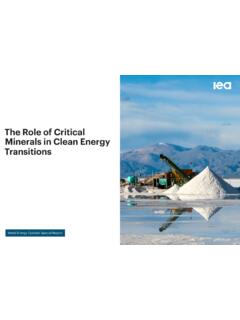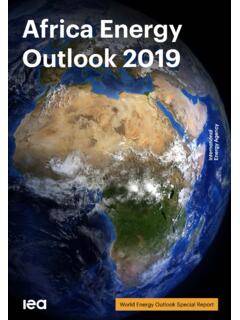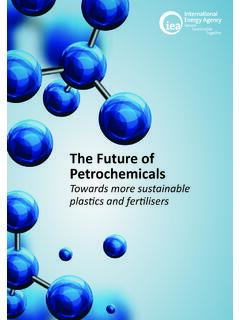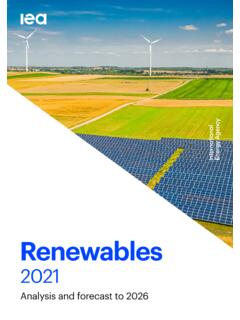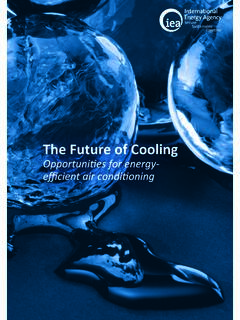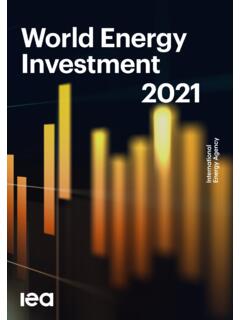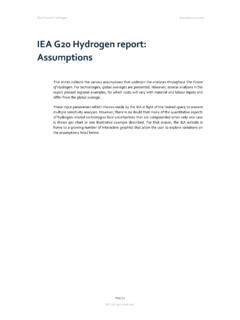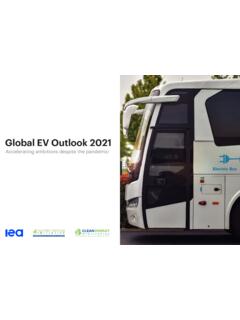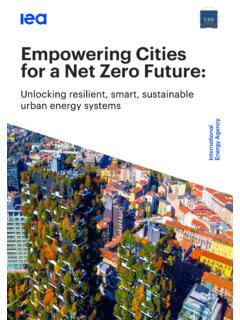Transcription of Ammonia Technology Roadmap - iea.blob.core.windows.net
1 Ammonia TechnologyRoadmapTowards more sustainable nitrogen fertiliser productionThe IEA examines the full spectrum of energy issues including oil, gas and coal supply and demand, renewable energy technologies, electricity markets, energy efficiency, access to energy, demand side management and much more. Through its work, the IEA advocates policies that will enhance the reliability, affordability and sustainability of energy in its 30 member countries, 8 association countries and note that this publication is subject to specific restrictions that limit its use and distribution. The terms and conditions are available online at publication and any map included herein are without prejudice to the status of or sovereignty over any territory, to the delimitation of international frontiers and boundaries and to the name of any territory, city or : IEA.
2 All rights Energy Agency Website: member countries: Australia Austria BelgiumCanadaCzech Republic DenmarkEstoniaFinland France Germany Greece HungaryIreland ItalyJapanKorea Luxembourg Mexico Netherlands New Zealand NorwayPoland Portugal Slovak Republic Spain Sweden Switzerland Turkey United Kingdom United StatesThe European Commission also participates in the work of the IEAIEA association countries:BrazilChinaIndiaIndonesiaMoroc coSingaporeSouth AfricaThailandINTERNATIONAL ENERGYAGENCYA mmonia Technology Roadmap Abstract Towards more sustainable nitrogen fertiliser production PAGE | 1 IEA. All rights reserved. Abstract Ammonia is the starting point for all mineral nitrogen fertilisers, forming a bridge between the nitrogen in the air and the food we eat. Around 70% of Ammonia is used to make fertilisers, with the remainder used for a wide range of industrial applications, such as plastics, explosives and synthetic fibres.
3 Ammonia may also serve as a low-carbon energy vector in the future, but that application is not considered within the core analytical scope of this Technology Roadmap . Ammonia production accounts for around 2% of total final energy consumption and of CO2 emissions from the energy system. An increasingly numerous and affluent global population will lead to growth in Ammonia production, during a period in which governments around the world have declared that emissions from the energy system must head towards net zero. This Technology Roadmap uses scenario analysis to explore three possible futures for Ammonia production. In the Stated Policies Scenario the industry follows current trends, making incremental improvements but falling well short of a sustainable trajectory.
4 In the Sustainable Development Scenario the sector adopts the technologies and policies required to put it on a pathway aligned with the goals of the Paris Agreement. The Net Zero Emissions by 2050 Scenario describes a trajectory for the Ammonia industry that is compatible with reaching net zero emissions globally for the energy system by 2050. The Roadmap concludes with a chapter outlining the necessary roles and actions of key stakeholders, namely governments, producers, and financial and research institutions, and establishes milestones and decision points. Ammonia Technology Roadmap Acknowledgements Towards more sustainable nitrogen fertiliser production PAGE | 2 IEA. All rights reserved. Acknowledgements This report was prepared by the Energy Technology Policy Division within the Directorate on Sustainability, Technology and Outlooks of the International Energy Agency.
5 The study was designed and directed by Timur G l (Head of the Energy Technology Policy Division). The analysis and production was co-ordinated by Araceli Fern ndez Pales (Head of the Technology Innovation Unit) and Peter Levi. The main authors were Sara Budinis, Alexandre Gouy, Peter Levi, Hana Mandov and Tiffany Vass. Several colleagues across the agency contributed analytical input, including Julien Armijo, Jose Miguel Bermudez Menendez, Tom s de Oliveira Bredariol, Uwe Remme and Jacopo Tattini. Valuable comments and feedback were provided by IEA senior management and other colleagues within the IEA, in particular, Tanguy de Bienassis, Ilkka Hannula, Paul Hugues and Keisuke Sadamori. Thanks also go to Jon Custer, Astrid Dumond, Tanya Dyhin, Merve Erdem, Grace Gordon, Jad Mouawad, Jethro Mullen, Rob Stone, Julie Puech, Therese Walsh and Wonjik Yang of the IEA Communications and Digital Office for their help in producing the report.
6 Caroline Abettan, Reka Koczka, Diana Louis and Per-Anders widell provided essential support. Justin French-Brooks carried responsibility for editing. The work could not have been undertaken without the financial support provided by the European Bank for Reconstruction and Development via the Shareholder Special Fund. The International Fertilizer Association and the European Bank for Reconstruction and Development provided valuable feedback and support throughout the project, in particular by facilitating communication with fertiliser companies and other experts, including at multiple in-person and online workshops. They also provided analytical feedback during the modelling phase and submitted detailed comments during the peer review process. Many experts from outside the IEA reviewed the report and provided comments and suggestions of great value.
7 They include: Walid Abdou Abu Qir Yasser Abdulrahim Alabbasi Gulf Petrochemical Industries Company Blake Adair Nutrien Ammonia Technology Roadmap Acknowledgements Towards more sustainable nitrogen fertiliser production PAGE | 3 IEA. All rights reserved. Mohamed Ali Arab Fertilizer Association Saleem Ali United Nations Environment Programme Volker Andresen International Fertilizer Association Florian Ausfelder DECHEMA Frank Brentrup Yara International Jonathan Brooks Organisation for Economic Co-operation and Development Trevor Brown Ammonia Energy Association Tom Bruulsema Plant Nutrition Canada Shawn Carnine CF Industries Lucia Castillo Nieto International Fertilizer Association Ciniro Costa Junior Institute for Forestry and Agricultural Management and Certification Laura Cross International Fertilizer Association Jacky de Letter Yara Jose De Sousa International Fertilizer Association Rebecca Dell ClimateWorks Foundation Alexander Derricott CRU Achim Dobermann International Fertilizer Association Harrie Duisters OCI Ermanno Filippi Casale Group Nicolo Giachino
8 European Bank for Reconstruction and Development Guillaume Gru re Organisation for Economic Co-operation and Development (OECD) Santiago Guerrero Organisation for Economic Co-operation and Development (OECD) Pat Han Haldor Topsoe Yvonne Harz-Pitre International Fertilizer Association Oliver Hatfield Argus Media Patrick Heffer International Fertilizer Association Julian Hilton Aleff Group Peter Hirsch European Bank for Reconstruction and Development Sjoerd Jenneskens OCI Glyn Johnson European Bank for Reconstruction and Development Rita Jupe International Fertilizer Association David Kanter New York University K K Kaul DCM Shriram Alzbeta Klein International Fertilizer Association Trine Kopperud Yara Dimitri Koufos European Bank for Reconstruction and Development Timothy Lewis AngloAmerican Lavan Mahadeva CRU Gianpiero Nacci European Bank for Reconstruction and Development Sachchida Nand The Fertiliser Association of India Klaus Nolker Thyssenkrupp Jan-Japp Nusselder OCI Cedric Philibert Former IEA Asim Qureshi Engro Ammonia
9 Technology Roadmap Acknowledgements Towards more sustainable nitrogen fertiliser production PAGE | 4 IEA. All rights reserved. Praveen Reddy BD Energy Systems Lorenzo Rosa University of California, Berkeley Khurram Saleem Fauji Fertilizer Company Limited Ahmed Shaaban Helwan Fertilizers Company Marina Simonova IHS Markit Upendra Singh International Fertilizer Development Center Michiel Stork Guidehouse Sammy Van Den Broeck Yara Wilfried Winiwarter International Institute for Applied Systems Analysis Xin Zhang University of Maryland Center for Environmental Science The individuals and organisations that contributed to this study are not responsible for any opinions or judgements it contains. The views expressed in the study are not necessarily views of the IEA s member countries or of any particular funder or collaborator. All errors and omissions are solely the responsibility of the IEA.
10 Ammonia Technology Roadmap Table of contents Towards more sustainable nitrogen fertiliser production PAGE | 5 IEA. All rights reserved. Table of contents Executive summary .. 8 Chapter 1. Ammonia production today .. 14 Ammonia and society .. 15 Nitrogen fertilisers: An indispensable input to our modern agricultural systems .. 17 Demand, supply and trade .. 23 Ammonia production fundamentals .. 26 Current and emerging production pathways .. 28 Economic considerations .. 39 Ammonia and the environment .. 43 An energy- and emissions-intensive sector .. 45 Non-CO2 environmental impacts .. 47 What will happen tomorrow to today s CO2 emissions from Ammonia production? .. 56 Chapter 2. The future of Ammonia production .. 61 Three contrasting futures for the Ammonia industry .. 62 The outlook for demand and production .. 65 The outlook for nitrogen demand, nutrient use efficiency and material efficiency.
